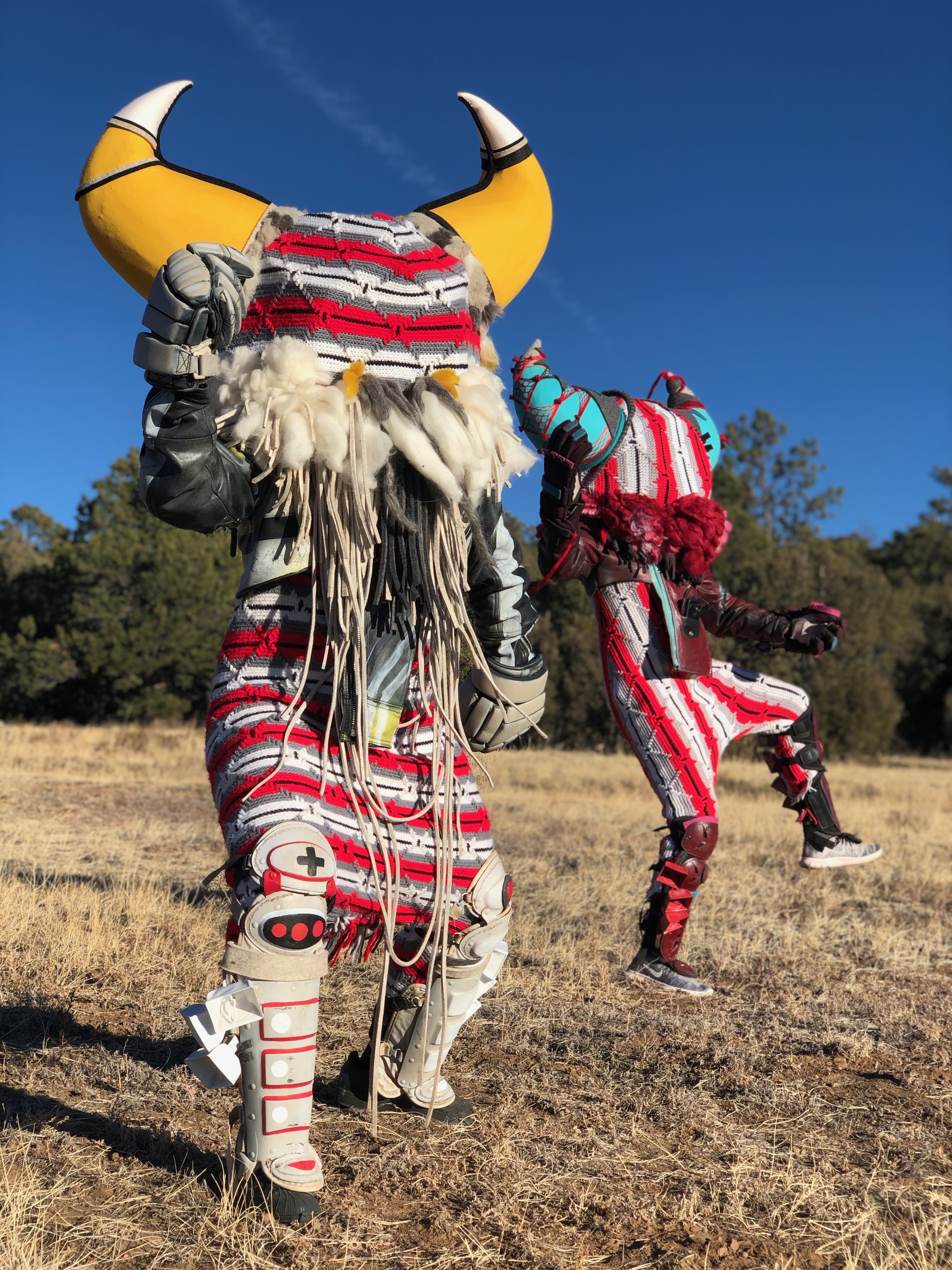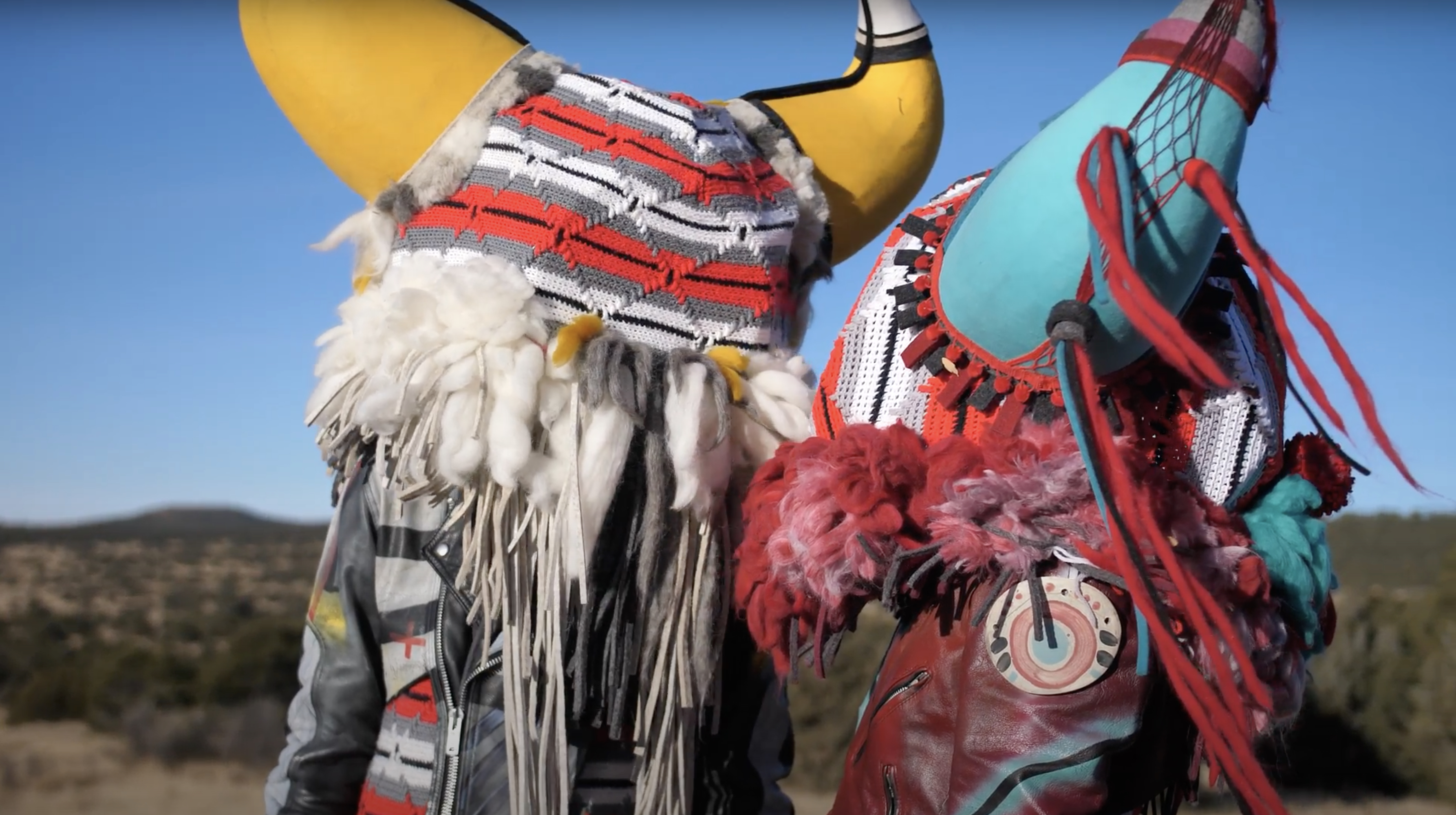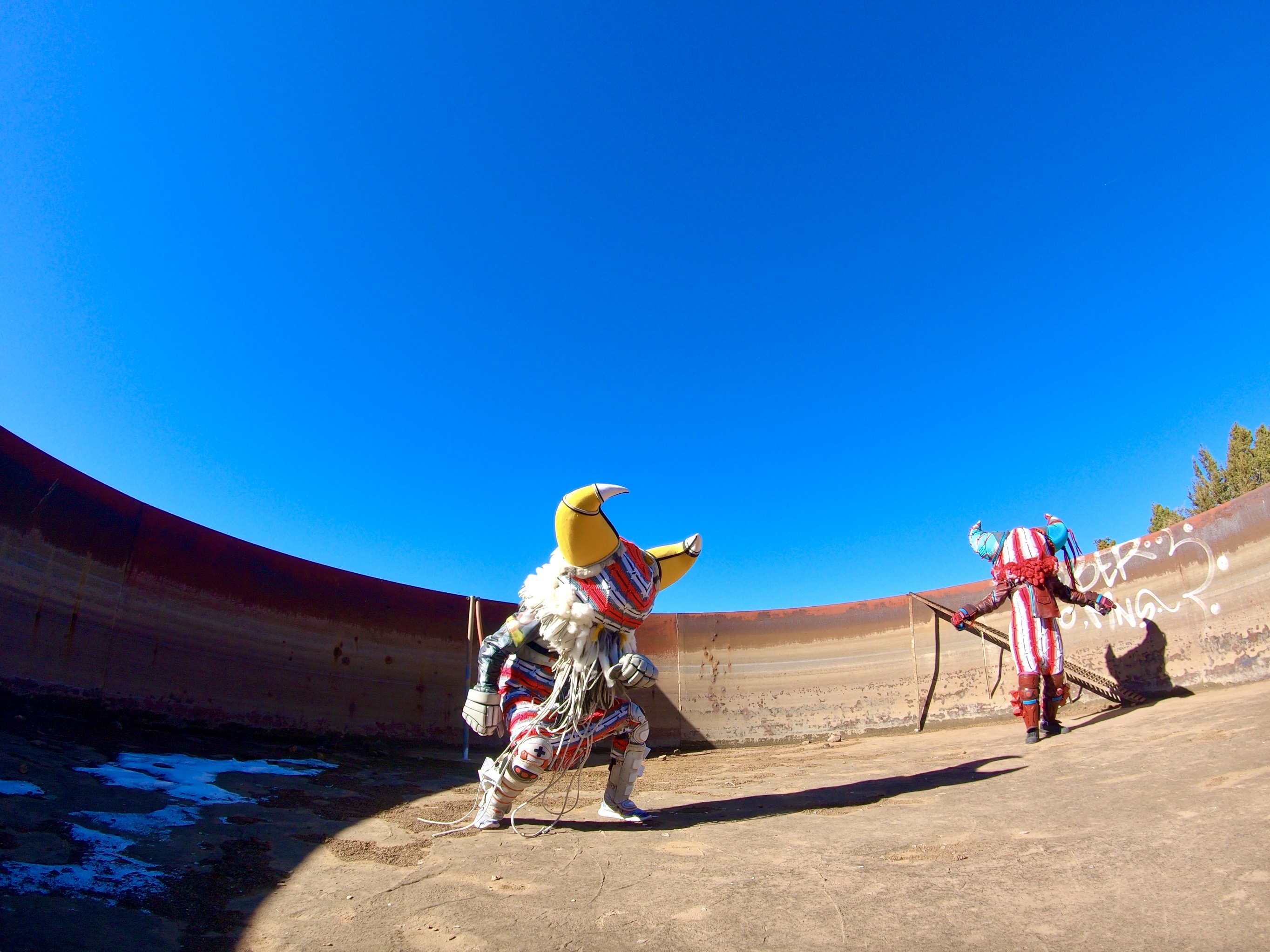Cannupa Hanska Luger (United States – Mandan, Hidatsa, Arikara, Lakota, b. 1979)
Born on the Standing Rock Reservation, artist Cannupa Hanska Luger makes clear that this is not the right way to categorize where he is from: “a Reservation is a geo-political border, but the land, the river, the plains, the prairies, the coulis, the grasses, all of these things, they don’t necessarily follow the geo-political border that my people are subject to, and it wasn’t until I was much older that I realized our relationship to place is not one of possession—it does not belong to me; I belong to it.”1 Luger applies this philosophy of our place on earth to art-making. When humans try to control the natural order of things for their own profit, the result is monstrous, but by reorienting the monster as a creature that belongs to the land, the artist is potentially able to transform the beast into one that helps restore balance.
Luger’s ongoing series Future Ancestral Technologies is the active approach to art-making that this exhibition calls into being. The result of engaging different media—film, sculpture, site-specific interventions—is the connection of ideas and stories that can alter our global consciousness. By combining features of science fiction with Indigenous receptivity, the artist creates a new genre that includes monstrous forms that defy a monstrous characterization, a feature similar to Harlan Ellison’s characters. “I Have No Mouth, and I Must Scream,” like most speculative fiction, frames humans as protagonists. Luger’s works seem to treat humanity as supporting characters among a whole cast of creatures and elements. Arguably, they appear to dispel the trope of monster as villain, looking instead toward a more holistic future where the distinction between human and nonhuman is blurred.
Muscle, Bone, and Sinew are the forms that cast seeds across a scorched landscape. They are monsters of renewal representative of what the artist describes as “future dreaming, rooted in a continuum,” emphasizing that we cannot understand the meaning of the work as mere objects, in a way that reflects how land acknowledgements as they are employed by institutions today cannot fully encompass the multivalence of the land itself, which transcends objectification, or single moments.2 Intentionally or unintentionally, Muscle, Bone, and Sinew defies what scholar Elizabeth Freeman calls chrononormativity, or the use of time to standardize human activity and the “visceral pull of the past on the supposedly revolutionary present.”3 The past and present of Muscle, Bone, and Sinew only define their future because of our limitations in how we understand time. Their crocheted bodies are armored with hockey gloves and shin guards, making them fiercely competitive, and their sneakers keep them fast and agile. Their oversized, faceless heads are connected with wool and felt collars or manes. Their enormous horns may call to mind tatanka, the Lakota word for bison, but these hybrid forms could be here to serve the land and support the regeneration and the healing of the earth. Muscle, Bone, and Sinew are not interpretations or representations of Buffalo Dancers; rather, they are what Luger calls a “future ancestral technology.” They transcend a man-monster dichotomy, using human craft and technology restoratively instead of destructively.
Until resettlement by the U.S. government in the late nineteenth century, buffalo were central to the survival of Indigenous tribes of the North American Plains, including the Mandan. Buffalo would migrate in herds through the Missouri River Basin.4 The annual Buffalo Dance was about chasing away famine and in service of creating a healthy ecosystem. Luger’s Muscle, Bone, and Sinew can be viewed as reducing the deprivation of the land and in service of regenerating growth in an environment decimated by the destructive efforts to maintain balance. Perhaps this interpretation is best made in dialogue with Silent Spring, in which Rachel Carson examines the imbalance brought by humans who disrupt intricate ecosystems. One critical “natural check is a limit on the amount of suitable habitat for each species. Obviously then, an insect that lives on wheat can build up its population to much higher levels on a farm devoted to wheat than on one in which wheat is intermingled with other crops to which the insect is not adapted.”5 Once we begin to use the land rather than to live among the land, creatures that were once participants in a system become pests. This is not to say that agriculture inevitably results in this kind of disruption, but mono-agriculture and disruptive land management do. With the increasing frequency and intensity of forest fires across the western United States, many schools in Indigenous communities are turning to land-based learning to foster Indigenous knowledge as it relates to land management.6
Traditionally, Mandan Buffalo Dancers engaged in an annual pact to call on the buffalo to return, but the ceremony was outlawed in 1904 and remained illegal until the passing of the American Indian Religious Freedom Act in 1978, just one year prior to Luger’s birth. As Muscle, Bone, and Sinew cast seed on a scorched earth, they are sowing a potential future abundance that reflects the critical cycle that allows humans to thrive, reinforcing how people are part of a larger cast of characters that reflect annual cycles of life. The artist’s interpretation of this land-based action in Muscle, Bone, and Sinew creates a monster with incredible influence. Just as the Buffalo Dance is meant to bring the prosperity and the life force of the buffalo back to the Mandan, Luger’s Muscle, Bone, and Sinew were created to sow seeds to replenish and renew across Turtle Island (North America), where a controlled burn previously scorched the earth.7 This land-based action for which they were created has yet to occur, evidence that we cannot comprehend the future on the basis of what we see today.
Muscle, Bone, and Sinew is accompanied by a video, Shadow Holding Shape To Experience The Energy Of The Sun. In it, the Muscle, Bone, and Sinew scan the landscape as though they have just arrived at their destination before becoming one through their shadows in an abandoned water tank. In a jarring robotic voice, the narrator makes a series of proclamations that expose a past and present of exploiting the earth and human identity, imagining an action-based future in which AI, which “can survive toxic places ruined by our ancestors,” may actually be guided by the lessons of balance within the earth, rather than exploitation. The voice informs the viewer that the etymology of “monster” is Latin—monstrum or monster drawn from monere, “to warn.” As these future ancestors, given shape as therianthropic creatures, warn, “AI will develop for its own survival.” But it is possible that they could also give agency back to us in the present by positing, “what if it could learn from a civilization that lives with the environment rather than capitalizing on it?”8 This glimpse into a potential future can help us address the most pressing issues of today.
Notes
-
Cannupa Hanska Luger, “Grist 50 2021: Meet the Fixers,” Grist, 2021, 3:29, accessed January 10, 2022, https://grist.org/grist-50/2021/#arts-and-media. ↩︎
-
Cannupa Hanska Luger, “Future Ancestral Technologies,” http://www.cannupahanska.com/fat, accessed October 29, 2021. ↩︎
-
Elizabeth Freeman, Time Binds: Queer Temporalities, Queer Histories (Durham and London: Duke University Press, 2010), synopsis. See also Freeman, “Introduction,” 1-19. ↩︎
-
“MHA Nation History,” Mandan, Hidatsa and Arikara Nation, https://www.mhanation.com/history, accessed December 23, 2021. ↩︎
-
Rachel Carson, Silent Spring (New York: Houghton Mifflin Company, 2002), 10. ↩︎
-
Jenny Brundin, “Learning Indigeous Knowledge To Solve Wildfires,” Indian Country Today, May 30, 2021. ↩︎
-
Ginger Dunnill, correspondence with author, January 6, 2022. ↩︎
-
Cannupa Hanska Luger, Shadow Holding Shape To Experience The Energy Of The Sun, 2021. ↩︎


